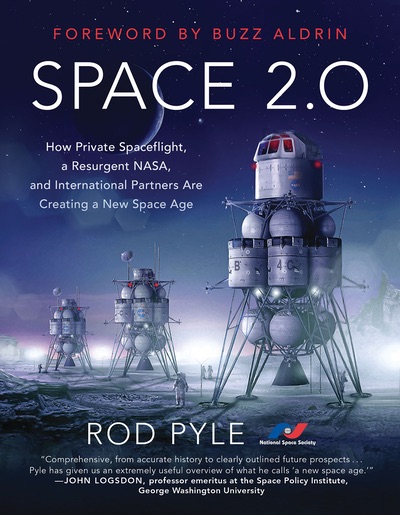Review: Space 2.0by Jeff Foust
|
| The book is intended to be a broad overview of this new space era, whatever version number you apply to it. |
So, a European might pick up the new book Space 2.0 and think it is a history text. It is not. Prolific author Rod Pyle uses that term for the new era of spaceflight in the post-shuttle era, one with greater roles for companies and new international partners. It stands in contrast with “Space 1.0,” which covers the early space age through the final flight of the shuttle, where government programs were dominant and space advocates sought, without success, to duplicate the success of Apollo.
The book is intended to be a broad overview of this new space era, whatever version number you apply to it. Some chapters are devoted to commercial space efforts, including one solely about SpaceX. Other chapters examine various countries and their roles in space, including chapters dedicated to China and Russia. And there’s a little history about the first space age, as well as visions of future space settlements (the book is associated with the National Space Society, including a pitch at the very end of the book to join the organization.)
The book is largely an introduction to this new space age. Those already familiar with what SpaceX is doing, or the plans of countries like China and Russia, will not find much in the way of new information in the book. It does have a considerable amount of original artwork to liven up the text. It could use, though, a little more factchecking: he describes watching the “dramatic return to flight” of SpaceX’s Falcon 9 in December 2015. However, the launch he is describing is taking place in the morning from Vandenberg Air Force Base in California, whereas that return-to-flight mission launched at night from Cape Canaveral, Florida. The launch he appears to be describing is one that took place more than two years earlier that was instead the first flight of the Falcon 9 v1.1 carrying a Canadian satellite called CASSIOPE.
At the end of the book, he offers a “plan for Space 2.0” predicting milestones in spaceflight from commercial suborbital activities to missions to Mars. There’s a bit of noteworth prescience there, too: he predicts crewed landings on the Moon by 2024, even though, at the time of the book’s publication earlier this year, NASA was aiming for landings by 2028. That timeline, though, got accelerated last month in a speech by Vice President Mike Pence to that 2024 date in the book.
No doubt, though, other elements of that plan will need to be amended as priorities change, schedules get pushed back, and players either enter the stage or withdraw. Does that mean a revised approach will be called Space 2.1, or Space 4.1?
Note: we are temporarily moderating all comments subcommitted to deal with a surge in spam.
